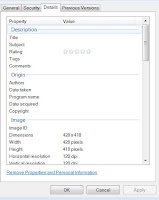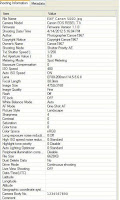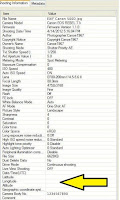Metadata isn't Metamucil but it often has the same run-on effect....
What the heck IS metadata and where do I find it?
Hmmm...
Good Question
Well for starters: THEY hide it from you. That is: the metaphysical and almighty THEY.
They hide because it has .... ready for it?
- There are NUMBERS in it.
- There are LETTERS in it.
- There are ARCANE and ODD and Human Undecipherable Sequences in it.
Metadata is the Sanctum Sanctorum for Computers
So of course, THEY don't what you to see it.
Because it's computer related, there is a tonnage of this sort of information layered on layer over every single aspect of the internet, the web (for those that make a distinction), programs and apps (for those that make a distinction) and nearly every single thing you do on a computer.
It's like an onion with 1,000,000,000,000,000 micro layers. There are so many micro layers I doubt there are many that know every single one of them. The NSA, GCHQ and Other State Agencies along with their in-house and out-house hackers might have a good handle on the value but I suspect even they get caught out on a few of them.
So perhaps it would be best to separate our view into two segments:
- Internet
- Programs
Once you "catch the wave", you can find a lot of stuff on your own.
So, metadata isn't necessarily awful or bad. It becomes awful or worse than awful, when it gets used for something other than it's original purpose. And that's 999999% of the problems today.
Metadata and it's cohorts are being used for something other than their original purpose.
All perfectly legal; brought to you by the folks who defined RELEVANT to mean EVERYTHING.
Lamp Shade Hat Dancing
We can start with that "oh so common" image of someone, a bit more full of it than others, doing The Lamp Shade Hat Dance at a party.
Yeah... THAT one...
Computer camera "photographs" are not like the old fashioned kind that used chemicals and special treated paper to make those Kodak Moments, if you remember Kodak at all. Cameras are everywhere now, but we will focus on the one in your Not-All-That-Smart Smartphone.
Basically it's 1 2 3.
- You point
- You click (which used be called shoot)
- You upload
You pick a format still, video, burst or select from a bunch of others. You get this nice image or video that you then post this out on social media to your friends, hopefully omitting the boss. There are however, billions and billions of others who scrape your social media pages for just this sort of thing. A whole sub-culture devoted to collection of Lamp Shade Hat Dance images.
So, skipping over the part where this image now becomes part of your life forever more and all future bosses will see this image when you go to apply for a job because your current boss just fired you for "behavior unbecoming". Unbeknownst to you, your company had a contract with a Reputation Cleaner to scrub their corporate image squeaky clean. The Rep Cleaner scraped the offending Lamp Shade Hat Dance image from the account of a friend of a friend of a friend and sent the harvested sample to your now old-boss.
Ok so we have an image... now what?
Once you get the image onto a computer, it will be a bit easier to see something akin to metadata but isn't really metadata but metadata like. Attached to your image is something called EXIF data.
So EXIF has an awful lot of junk stuff that's part of the image. There's a lot of normal good stuff there too. Most of it, no one cares about except professionals (of all persuasions). But you have to LOOK to find it.
Find an image, any image will do and Right Click the name. You will get the famous Context Window. At the bottom is the option: Properties. Click that to open the Properties Page. So far pretty ho-hum.
Next, select the tab: Details.
OH!There are a lot of details. Depending on what and how you got the picture much of it maybe blank. But a bunch of other stuff may not be blank. Scroll down and take a good look.
Oh Yeah!
EXIF 101
 |
| EXIF 101 |
So this sort of metadata isn't ugly until you start to Catch the Wave that it can be changed. In Windows you can click in any field and update the information. Clicking the Title Field will let you add a Title which isn't the same as the File Name. Clicking the Copyright lets you put in copyright information. In theory.
You don't actually have to use any of these fields for what the field name says.
Let me repeat that.
Just because a field says TITLE you don't have to put "Lamp Shade Hat Dance" in the space.
Honesty is fine, but what metadata extortionists want most from you is your GULLIBILITY. Yeppers that's really all they want. Because they expect you will be gullible enough to fill in these sorts of options Honestly and Truthfully every time. And it's not surprising, the vast majority of us do.
If you scroll down some more you might be surprised. There are some fields that you cannot alter such as those in the IMAGE subsection. Much of what's in that location relates directly to the computer representation of the image which allows the computer to display the image as it is defined in that section. Manually changing this area is blocked because the computer needs it. If the computer needs it and you want to change it, you have to use a program to do it, like Paint or Photoshop which can supply the required metadata changes as you resize or alter the image.
EXIF 102a
 |
| EXIF 102a |
It is likely that on the images you checked, the vast majority of these fields are blank. They aren't used at all but your image still carries this information potential everywhere it gets sent and is displayed to anyone who knows how to open the Properties Page.
Now check this list of field names and look for one that says: Geotag or Location or Latitude or Longitude or Altitude or Geographic Coordinates.
EXIF 102b
Geotagging for fun and profit
 |
| EXIF 102b |
All of these systems are marketed as "helpful". All of them have metadata components too.
GPS is the best known of them.
Smartphones by default add GPS data to everything. If you have LOCATON SERVICES: ON then you get GPS metadata added to every photograph. This is also marketed as being "helpful".
Perhaps the manufacturers think that when you eventually get dementia after binge watching every mega costume drama made, having a geotag on an image will jog your memory of some real life event. There are lot of other people interested in where you go, when, how and what you do at that location. When you combine it with the ability to tell if your hands are moving or if your heart is still beating, this makes a powerful combination.
Some people turn off this feature. If they turn it off then, in theory, no geotags should be found on an image at the time the image was taken. This may or may not be true. Having a visibly blank data field is not the same as knowing there is no data hidden and embedded elsewhere.
The importance of geotags is so great, Google and Facebook are working with the US Government to put geotags on every image in their respective archives that doesn't have one. Because all those vacation pictures you uploaded now belong to FB and Google, they can do with their electronic image whatever they want.
They can do that to my pictures?
Yes. Because, you gave it to them.
So the current plan is to overlay all the matching geotags, the world is after all somewhat finite; using your pictures plus Sat-Intel to map out the detailed landscape at every location. Trees, shrubs, buildings, and all the finer details you captured in your vacation images plus the gross level image of Sat-Intel.
Next using the composite view, they will scan all non-geotagged images belonging to FB, Google and the NSA+chums matching up the details from their composite to what is in the image. Based on this they will assign them a geotags.
You may not be able to see the Geo Tag Property with a simple program or see all the kinds of data associated with high end devices. An advanced EXIF editor is needed.
At the bottom is the option: REMOVE PROPERTIES and PERSONAL INFORMATION
Clicking this brings up another page where you can erase some or all of the displayed data. It does not necessarily remove ALL optional data and it may or may not remove the HIDDEN data. Which brings up another problem with metadata.
Metadata definitions change all the time. New ones are added and old ones either removed or repurposed. The ability of any program to display or edit metadata depends on what versions of metadata the program recognizes. Programs might not display geo-coordinates simply because those fields were not there when it was created. The program displays what it can but you will never know if there is more there that is not displayed unless you start metadata hunting or acquire a program that handles more metadata types.
There are similar tag fields on audio files. iTunes has a pretty good field editor but in early days as the number of fields increased, iTunes didn't support changes to all the new fields. I used a third party external programs to change the fields. I could tag multiple files at one time and do mass updates. Just because iTunes didn't display them other devices did.
So, here's the rhetorical question:
If there isn't anything harmful in metadata why is there an option to delete it?
Because there is harmful stuff in metadata and there are plenty of people looking for it. Your Lamp Shade Hat Dance cost you your job and may prevent you from ever getting another one. That's a pretty harmful and drastic result.
Now to extend our discussion some, the metadata you see via EXIF editors is not all the metadata there is.
Are you shocked?
I hope not.
Embedded directly IN the image is more metadata. This data is not accessible to the average shmoe. It takes some serious geeking to see it. You need a hex editor at the very least and an in depth knowledge of how a computer stores images. Along with these you will find more sub-sub-sub levels of metadata.
EXIF 103
 |
| EXIF 103 |
An example: There is an audit log of file changes to the image. This is called the UNDO list but really it's just a log of who changed what when where with more metadata than what you've been looking at. Yet another onion level. Metadata can be useful in a number of ways. When you upload an image portions of the metadata can be used by the web service to better display the image. Some of it maybe helpful in finding your image in a photo archive. By now, you probably have figured out that the archive itself adds metadata identifiers to your image too.
EXIF 104
 |
| EXIF 104 |
Adding in "identifiers" is how Google, Facebook along with all other internet related businesses like ATT, Comcast and others keep track of YOU. There are special law enforcement groups specifically tasked with adding and hiding metadata IDs in certain types of pictures to track people of interest to them. These pictures, if found on your computer, can send you to prison for a very long time. Metadata tracks how they got to your computer - maybe.
Even professionals get surprised about what metadata shows about their work.
Going to a war zone is dangerous - period. Going to a war zone to take pictures and video is really dangerous - as the deaths of documentary journalists can attest.
A few years back, a well known photo journalist took an outstanding image in combat. It was extraordinary. A major news outlet carried the image and the stories associated with it. Then metadata happened. The news outlet fired the photo journalist. Not because the stories were false but because the photographer had photoshopped the image. The news outlet said that it only buys un-doctored images and this was a violation of their policy.
The news outlet did not relate how they discovered or verified the alteration but within each image are levels of details that even the professionals have a hard time tracking. Soon enough the True Original and the Altered Image were on display. The bottom left corner of the image had been over-written by a photo editing program to stamp out a camera bag that was in the frame. This photo stamping overwrites the selected area with another portion of the picture. In this case the photo journalist had stamped out the camera bag matching that area to the rest of the terrain.
There was a lot of sputtering and stuttering as journalists and photographers debated the de-merits of the offense. For an odd reason the consensus was if the photographer had CROPPED the image to exclude the bag that was OK but because he had cropped the camera bag by STAMPING it, this was not.
This image's legacy is the same as the Lamp Shade Hat Dance image.
The news outlet did not relate how they discovered or verified the alteration but within each image are levels of details that even the professionals have a hard time tracking. Soon enough the True Original and the Altered Image were on display. The bottom left corner of the image had been over-written by a photo editing program to stamp out a camera bag that was in the frame. This photo stamping overwrites the selected area with another portion of the picture. In this case the photo journalist had stamped out the camera bag matching that area to the rest of the terrain.
There was a lot of sputtering and stuttering as journalists and photographers debated the de-merits of the offense. For an odd reason the consensus was if the photographer had CROPPED the image to exclude the bag that was OK but because he had cropped the camera bag by STAMPING it, this was not.
This image's legacy is the same as the Lamp Shade Hat Dance image.
Metadata doesn't go away.
Which brings us back to the beginning.
Metadata is not bad. It gets badly used. It tracks changes that otherwise would never be noticed. There is no way to remove it completely. You have little control over what's there. You have no input into what's added or excluded. You have no control over who gets it or what they do with it but that's not the end.
Special technologies now allow for the editing of images, documents, pdfs, voice and media without leaving the required metadata finger prints.
That's right.
Someone can now photoshop "anyone or anything" dancing with that lamp shade next to the offending camera bag and no one can ever tell that this wasn't a real image. It cannot be detected as a fake in any way.
If metadata provides an audit trail of what you do and where you go and who you hang around with, and allows us to tag images with useful information then what is the purpose of invisible metadata?
Invisible metadata is not the same as Omitted metadata. Omitted metadata is just blank. Invisible metadata happens outside of normal metadata. Invisible metadata by-passes everything. It's a method of forging information into an image, document, video, audio or other metadata related system - which means everything on the internet.
The advent of these metadata forgeries will have a profound effect on everything.
- There are people who openly Share Metadata
- There are lives that depend on Omitting Metadata
- There are those who actively Falsify Metadata
- There are careers incumbent on Invisible Metadata
The majority of people know that metadata is what we use "to kill people"; metadata is "Warheads on Foreheads" and viewed as the perfect tracking system; getting more sophisticated at each iteration. But if metadata can be forged leaving a fake audit trail; if metadata can obliterate and invisibly alter every component that relies on metadata then the diversion of metadata for other purposes becomes an unreliable practice.
Using metadata outside it's Original Purpose becomes even more hazardous than a Lamp Shade Hat Dance with a Camouflaged Camera Bag.
The first part of catching a wave is knowing how to find the ocean.

No comments:
Post a Comment